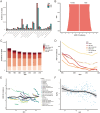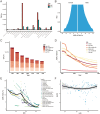Global, regional and national burden of orofacial clefts from 1990 to 2019: an analysis of the Global Burden of Disease Study 2019
- PMID: 37232757
- PMCID: PMC10228319
- DOI: 10.1080/07853890.2023.2215540
Global, regional and national burden of orofacial clefts from 1990 to 2019: an analysis of the Global Burden of Disease Study 2019
Abstract
Background: Orofacial clefts are the most common congenital malformation, but the global burden and trends of orofacial clefts have not been comprehensively analysed. The aim of this study was to assess the global incidence, deaths and disability-adjusted life years (DALYs) of orofacial clefts by countries, regions, sex and sociodemographic index (SDI) from 1990 to 2019.
Methods: The data on orofacial clefts were obtained from the Global Burden of Disease Study 2019. The incidence, deaths and DALYs were analysed by countries, regions, sex and SDI. Age-standardized rates and estimated annual percentage change (EAPC) were calculated to evaluate the burden and temporal trend of orofacial clefts. The association between EAPC and the human development index was assessed.
Results: Globally, the incidence, deaths and DALYs of orofacial clefts decreased from 1990 to 2019. The high SDI region showed the biggest downward trend in incidence rate from 1990 to 2019, along with the lowest age-standardized death rate and DALY rate. Some countries, such as Suriname and Zimbabwe, experienced increased death rate and DALY rate over time. The age-standardized death rate and DALY rate were negatively associated with the level of socioeconomic development.
Conclusion: Global achievement is evident in the control of the burden of orofacial clefts. The future focus of prevention should be on low-income countries, such as South Asia and Africa, by increasing healthcare resources and improving quality.KEY MESSAGESThis is the most recent estimate of the global epidemiology of orofacial clefts, with some countries not previously assessed.The global burden of orofacial clefts showed downward trends from 1990 to 2019; however, some low-income countries are still suffering from increasing burdens.Effective measures should be taken to reduce the burden of orofacial clefts in the uncontrolled regions.
Keywords: DALYs; Orofacial clefts; deaths; global burden; incidence.
Conflict of interest statement
No potential conflict of interest was reported by the author(s).
Figures




References
-
- Holzmer S, Davila A, Martin MC.. Cost utility analysis of staged versus single-stage cleft lip and palate repair. Ann Plast Surg. 2020;84(5S Suppl 4):S300–S306. - PubMed
-
- Nasreddine G, El Hajj J, Ghassibe-Sabbagh M.. Orofacial clefts embryology, classification, epidemiology, and genetics. Mutat Res Rev Mutat Res. 2021;787(2021):108373. - PubMed
-
- Watkins SE, Meyer RE, Strauss RP, et al. . Classification, epidemiology, and genetics of orofacial clefts. Clin Plast Surg. 2014;41(2):149–163. - PubMed
Publication types
MeSH terms
LinkOut - more resources
Full Text Sources
Medical
